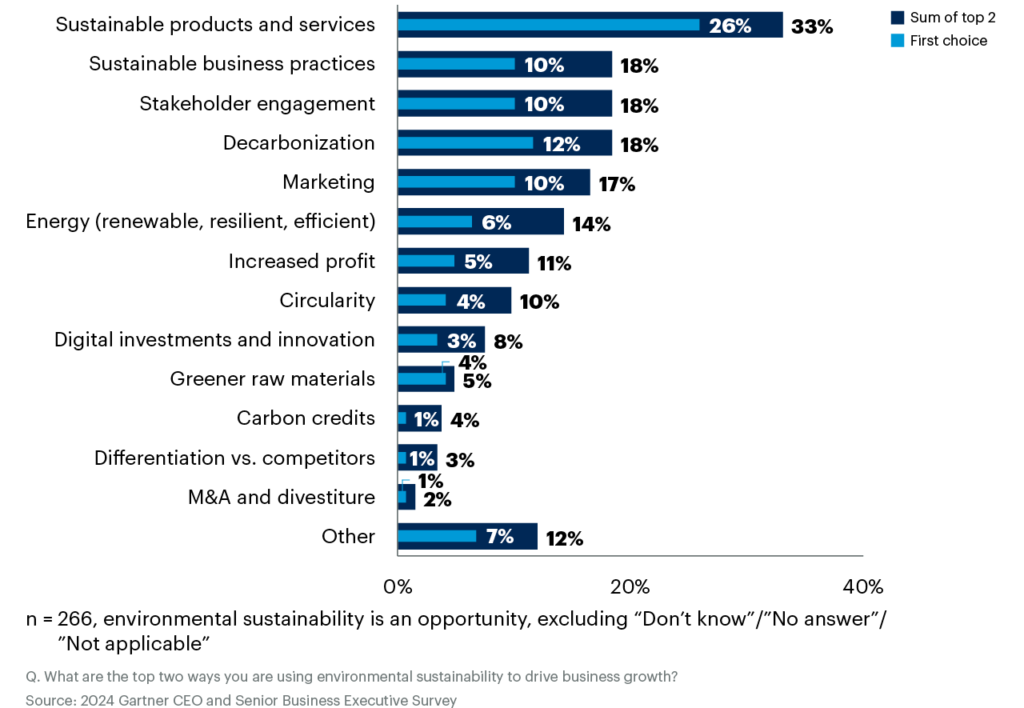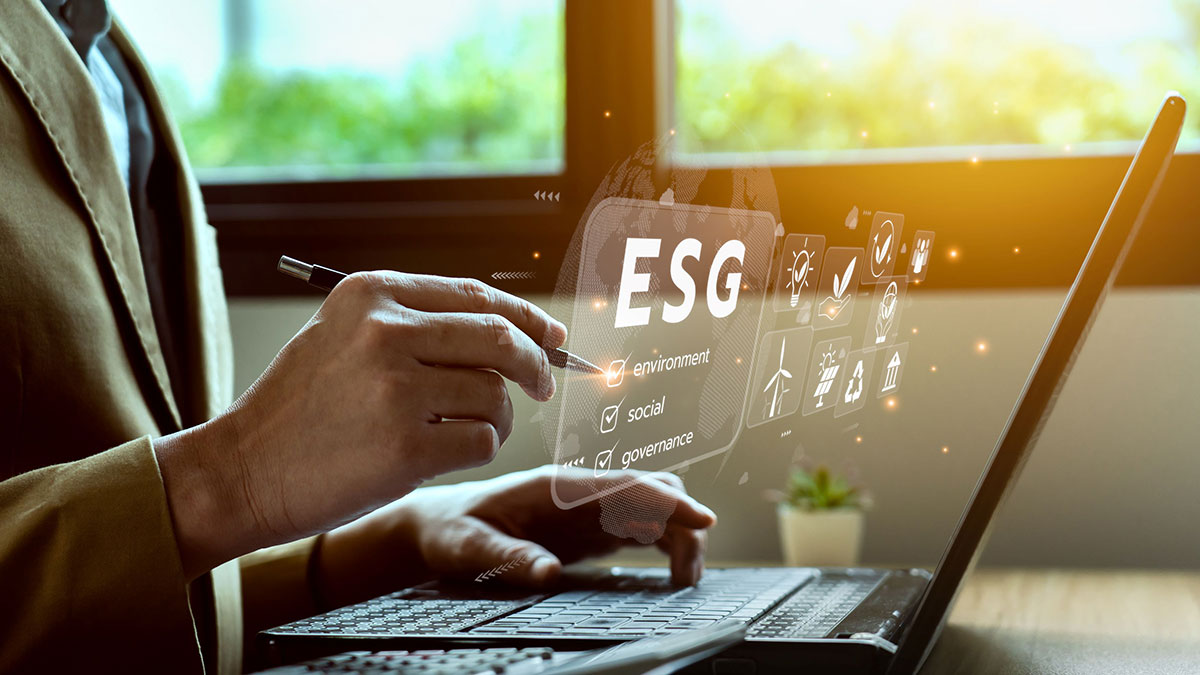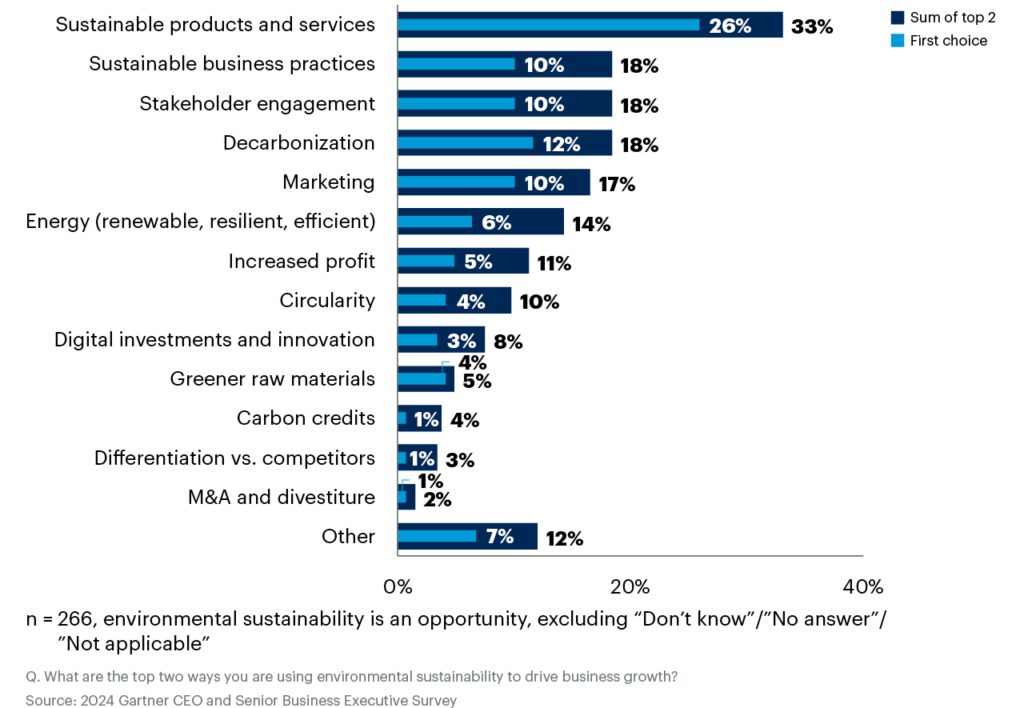การ์ทเนอร์เผยผลสำรวจซีอีโอและผู้บริหารระดับสูงล่าสุดพบว่าซีอีโอทั่วโลก 69% เห็นความยั่งยืนคือโอกาสการเติบโตทางธุรกิจที่สำคัญในปีนี้
คริสติน โมเยอร์ รองประธานฝ่ายนักวิเคราะห์ของการ์ทเนอร์กล่าวว่า “ในขณะที่ซีอีโอมีการปรับกลยุทธ์ระยะยาวกันใหม่ ความยั่งยืนด้านสิ่งแวดล้อมยังคงเป็นหนึ่งในปัจจัยสำคัญที่กำหนดกรอบการแข่งขัน สภาพเศรษฐกิจได้กระตุ้นให้เกิดกระแสการวกกลับของความสนใจเรื่องสิ่งแวดล้อม สังคมและธรรมาภิบาล (ESG) แม้ว่าจะมีการฟอกเขียว หรือ Greenwash ในองค์กรต่าง ๆ มากมาย และไปให้ความสำคัญกับผลกำไรจากต้นทุน อย่างไรก็ตามพันธกิจภาพรวมของซีอีโอยังไม่เปลี่ยนไปแต่อย่างใด”
จากการสำรวจซีอีโอและผู้บริหารระดับสูงของการ์ทเนอร์ในปี 2567 ระหว่างเดือนกรกฎาคมถึงธันวาคม ปี 2566 โดยรวบรวมความคิดเห็นของบรรดาซีอีโอและผู้บริหารระดับสูงในองค์กรธุรกิจต่าง ๆ ที่อยู่ในอุตสาหกรรมหลากหลาย ในกลุ่มรายได้และขนาดองค์กรแตกต่างกันออกไปมากกว่า 400 ราย จากทวีปอเมริกาเหนือ ยุโรป เอเชีย/แปซิฟิก ละตินอเมริกา ตะวันออกกลาง และแอฟริกาใต้
“ความยั่งยืนยังเป็นปัจจัยสำคัญของการทำธุรกิจที่อยู่ใน 10 อันดับแรกอย่างต่อเนื่อง โดยแซงหน้าเรื่องผลิตภาพ (Productivity) และประสิทธิภาพ (Efficiency) ขึ้นมาในปีนี้ ซึ่งผู้นำและนักลงทุนต่างทราบดีว่าองค์กรที่มีพฤติกรรมที่ไม่ใส่ใจต่อสิ่งแวดล้อมเป็นความเสี่ยงที่สร้างผลกระทบระยะกลางถึงระยะยาวต่อผลลัพธ์ทางธุรกิจ โดยมีราคาที่ต้องจ่ายมหาศาลหากละเลยปัจจัยในด้านสิ่งแวดล้อม อย่างไรก็ตามซีอีโอที่มีความเฉลียวฉลาดจะตระหนักดีว่าความท้าทายด้านความยั่งยืนครั้งใหญ่นี้จะสร้างโอกาสทางธุรกิจใหม่ ๆ เพิ่มขึ้นด้วย” โมเยอร์ กล่าวเพิ่มเติม
บรรลุการเติบโตทางธุรกิจอย่างยั่งยืน
จากการสำรวจประจำปีของการ์ทเนอร์ พบว่าแนวทางหลักที่ซีอีโอใช้ความยั่งยืนขับเคลื่อนการเติบโตทางธุรกิจ ได้แก่ การใช้ผลิตภัณฑ์และบริการที่ยั่งยืน (33%) ยึดแนวทางปฏิบัติทางธุรกิจที่ยั่งยืน (18%) สร้างการมีส่วนร่วมของผู้มีส่วนได้ส่วนเสีย (18%) และมุ่งลดการปล่อยคาร์บอน (18%) โดยการลงทุนด้านนวัตกรรมและดิจิทัลอยู่ในอันดับที่เก้าที่ 8% (ดูรูปที่ 1)
ภาพที่ 1: ความยั่งยืนสิ่งแวดล้อมขับเคลื่อนการเติบโตทางธุรกิจ

“เทคโนโลยีดิจิทัลสามารถเร่งการบรรลุเป้าหมายด้านความยั่งยืน นอกจากการปฏิบัติตามข้อกำหนดที่ช่วยให้องค์กรบรรลุเป้าหมายต่าง ๆ อย่างการเปิดรูปแบบธุรกิจใหม่ ๆ และการสร้างช่องทางรายได้ใหม่ ๆ” โมเยอร์กล่าวเพิ่มเติม
ตามรายงานของการ์ทเนอร์ยังเผยว่าเทคโนโลยีดิจิทัลนั้นมีบทบาทสำคัญต่อการขับเคลื่อนผลลัพธ์ด้านการเงินและความยั่งยืน ตัวอย่างเช่น Internet of Things (IoT), ข้อมูลและการวิเคราะห์ (Data & Analytics) ที่สามารถปรับใช้ได้อย่างเหมาะสม ช่วยลดต้นทุนและการปล่อยก๊าซเรือนกระจก โดยมี AI และ IoT คอยช่วยลดต้นทุนของอาหารและขยะที่สูญไป ขณะที่ตลาดในระบบเศรษฐกิจหมุนเวียน (Circular Economy) สามารถสร้างรายได้ใหม่และลดขยะไปพร้อม ๆ กัน
Climate Change คือ วาระสำคัญขับเคลื่อนการดำเนินธุรกิจ
ผลสำรวจของการ์ทเนอร์เผยว่าซีอีโอ 54% ระบุว่าธุรกิจของพวกเขาได้รับผลกระทบจากสภาพอากาศที่เปลี่ยนแปลงในระดับปานกลางเป็นอย่างต่ำ และมากกว่าครึ่งหนึ่ง (51%) ยอมรับว่าสภาพอากาศเปลี่ยนแปลงเป็นสาเหตุที่ทำให้พวกเขาต้องอยู่ในขั้นของการปรับเปลี่ยนแผนการดำเนินงานหรือปรับเปลี่ยนไปแล้ว
“ซีอีโอเห็นการเปลี่ยนแปลงสภาพภูมิอากาศกำลังทำให้สภาพอากาศแปรปรวนและกระทบตรง ๆ ต่อการดำเนินธุรกิจของพวกเขาแล้ว และการดำเนินงานจะต้องปรับเปลี่ยนใหม่ โดยนำเทคโนโลยีมาใช้ขับเคลื่อนการเปลี่ยนแปลง โดยเฉพาะอย่างยิ่งในห่วงโซ่อุปทาน” โมเยอร์กล่าวเพิ่มเติมว่า
ผลสำรวจของการ์ทเนอร์ เผยว่าผลกระทบใหญ่ที่สุดของการเปลี่ยนแปลงสภาพอากาศที่ซีอีโอกล่าวถึงคือ พลวัตการดำเนินงาน (30%) โดยเฉพาะการเปลี่ยนแปลงด้านโลจิสติกส์ เช่น การจัดเก็บสินค้า การกำหนดเวลา และกำหนดเส้นทางการจัดส่ง หรือการย้ายสถานที่ (ซึ่งรวมถึงการทำงานในพื้นที่ใกล้เคียง) อยู่ในอันดับสอง (14%) รองลงมาคือระบบอัตโนมัติ เทคโนโลยี และข้อมูล (13%)

